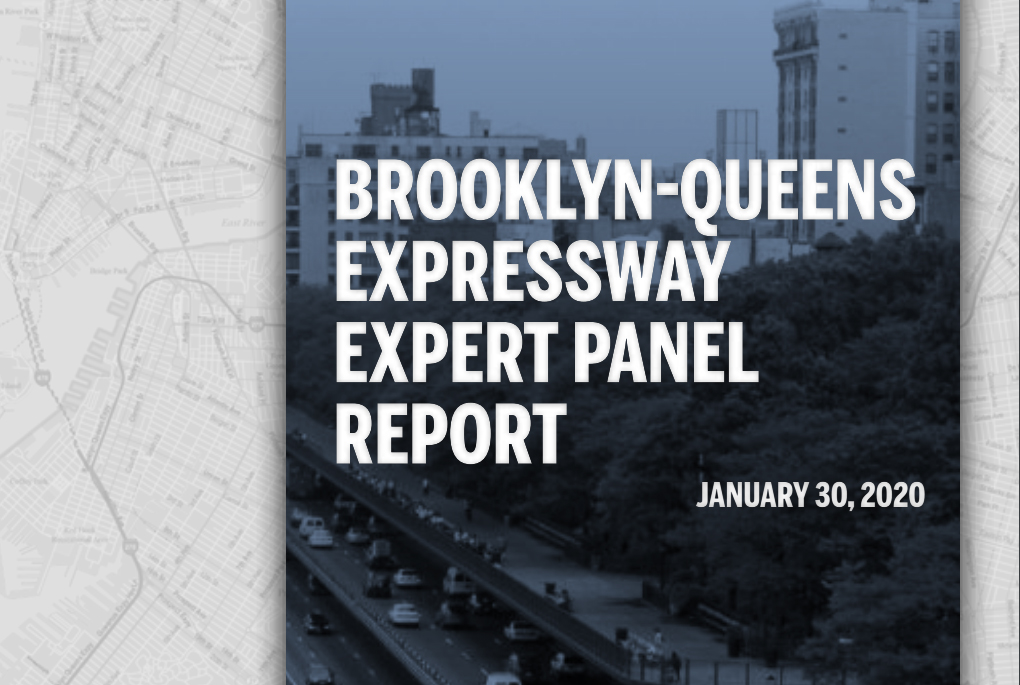by: AIA New York
An Expert Panel convened by Mayor Bill de Blasio has released a report detailing recommendations on how to move forward with repairs to the Brooklyn-Queens Expressway (BQE) triple cantilever.
The Panel, which included Benjamin Prosky, Assoc. AIA, Executive Director, AIANY and Center for Architecture, was created in April 2019 to review the city’s plans for the BQE. After new data collection and analysis by diverse experts from a range of industries, the group called for a much broader plan to reimagine the entire BQE corridor. They also rejected any proposal to build a temporary highway at the Brooklyn Heights Promenade or Brooklyn Bridge Park.
“What the Panel adeptly uncovered,” said Prosky, “is that the problems that plague the BQE stretch far beyond this isolated section. While the triple cantilever under Brooklyn Heights does require immediate intervention, the entire BQE corridor, from Staten Island to Queens, must be reimagined. The BQE has torn communities apart since the 1950s, and the panel asserts that now is the moment to call for a more ambitious reimagining of the infrastructure project. Through innovative urban designs, the reimagined BQE should reduce vehicular volume and emissions, knit communities back together, and create green space and waterfront access. AIA New York calls on city, state, and federal agencies to work together to improve the entire BQE corridor, rather than addressing the issue in a piecemeal approach. Architects stand by ready to design a new and better BQE for all New Yorkers.”
Key Report Findings:
- The Panel worked with the NYC Department of Transportation (DOT) to collect new, more precise data that suggests that the presence of many overweight trucks and faster-than-expected deterioration may cause sections of the road to become unsafe and incapable of carrying current traffic within five years.
- The cantilevered section of the BQE will need to be repaired immediately. DOT should redefine its program to be limited to a four-lane highway that will be capable of handling a traffic load adequate for the region, but with volumes slightly lower than current usage.
- The Panel rejects any proposal to build a temporary highway at the Brooklyn Heights Promenade or Brooklyn Bridge Park. Additional proposals to repair and improve the 1.5-mile project area have been made, but they are flawed: their capacity assumptions were incorrect, as they assumed maintaining existing volumes, they compromise adjacent public spaces in ways that are unacceptable, or they require levels of investment that are not realistic or equitable.
Report Recommendations:
- DOT should immediately conduct all necessary maintenance and repair work based on the current condition of the roadway and should have every appropriate tool at its disposal to do the necessary work to keep the road safe and drivable.
- Actions to mitigate the impact of traffic—both to extend the highway’s life and to facilitate transition to a zero-growth traffic future—must be undertaken right away. These include:
- Enforcing existing restrictions on overweight trucks and impose new restrictions on heavy trucks to extend the life of the current structure
- Implementing a comprehensive Transportation Management Plan to address planned and unplanned changes in local and regional travel patterns during construction
- Pricing strategies to reduce demand, such as congestion pricing and split tolling on the Verrazano Bridge
- Closure and restrictions of ramps and connections to and from the BQE
- Diversion to and management of Brooklyn Battery Tunnel traffic
- Permit small trucks on Belt Parkway
- Create and support alternatives for local freight
- Divert some BQE traffic to the Williamsburg Bridge
- Promote a regional dispersion of traffic
- Transit improvements to reduce demand on the BQE, including increasing G-train capacity by greater frequency and longer trains, completing the BQX, express service on the D, R and F lines, new ferry service, and expanded use of express bus service
- Work needs to be undertaken to devise a broader transformation of the entire BQE corridor from Staten Island to Queens. Any new, corridor-wide vision must be grounded in today’s transportation and sustainability goals: minimizing growth in road traffic, maximizing public transit usage, providing alternatives for local freight, protecting the environment, and promoting quality of life in adjacent communities.
- Given the need for multi-jurisdictional cooperation on both immediate next steps and a long-term vision, a joint working group of government and community stakeholders along the corridor should be convened immediately to oversee both and move this corridor-wide project forward.
As the Mayor’s Expert Panel worked on their report, members of the AIANY Planning & Urban Design Committee and the AIANY Transportation & Infrastructure Committee formed a taskforce to hold workshops examining many of the same proposals and information provided to the Mayor’s panel. These workshops culminated into a complimentary report finalized in July 2019. Please see the taskforce’s full report here.








